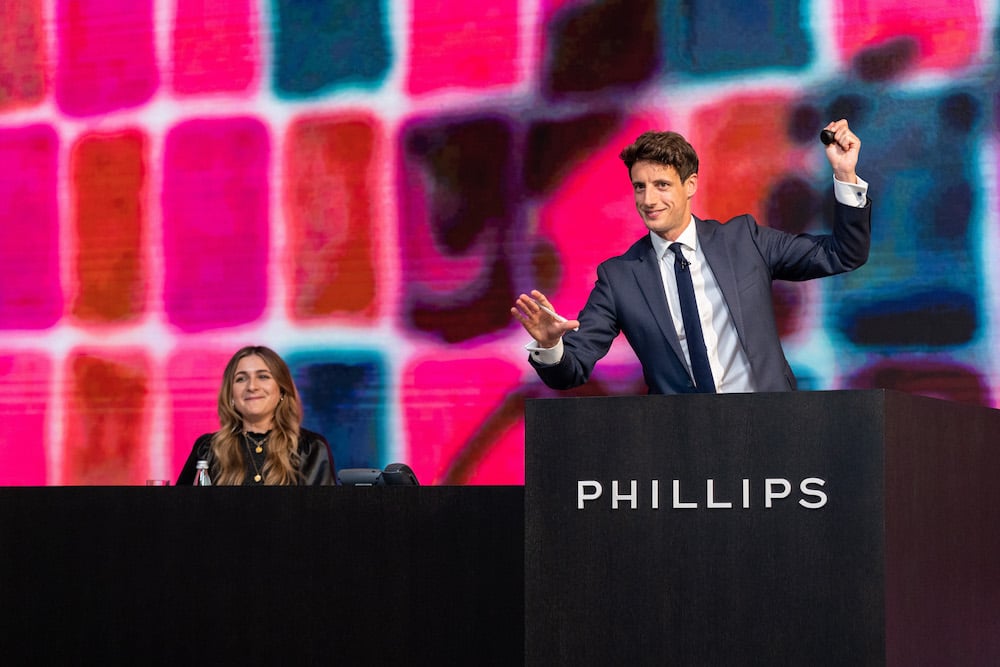
Phillips’s evening sale of 20th-century and contemporary art on Wednesday cemented the trend that has swept major auctions around the globe in recent months: frothy bidding for young—and especially young and figurative—painters, with more measured bidding for established blue-chip names.
In all, the sale—held in the hybrid format that has now become de rigueur as a result of the pandemic—generated an above-estimate $118 million. That’s well over double its equivalent 2020 total and up nearly 20 percent from its May 2019 sale.
Notably, Phillips exceeded its presale high estimate of $113 million even after two lots were withdrawn just before the opening hammer, bringing the total number of works on offer down to 48. (The house furnished a revised estimate of $76.7 million to $102.4 million, which it easily cleared.)
Wayne Thiebaud Winding River (2002). Image courtesy Phillips.
Of the 48 lots on offer, 17—around 35 percent—carried guarantees. All but two were third-party, meaning they were supported by financial commitments made in advance by outside backers.
All 48 works sold, which the auction house trumpeted as a “white-glove” sale. The term seems to be getting tossed around a lot in auction parlance these days, but the question of whether it truly applies when lots are withdrawn right beforehand—presumably because of a lack of interest—is still subject to debate.
Phillips continued the trend of pushing the boundaries of traditional auction categories, offering works by contemporary-sale mainstays such as Andy Warhol, Jean-Michel Basquiat, and Joan Mitchell alongside the likes of Norman Rockwell and Winston Churchill, who are more often included in American and British art sales, respectively.
David Hockney, A Neat Lawn (1967). Image courtesy Phillips
Much of the competition came from specialists on the phone with clients in New York, London, and Hong Kong. But the presence of online bidding was also notable. Auctioneer Henry Highley was at times highly specific about where those online bids were coming from, ticking off locations ranging from Samoa to Arizona.
The same online bidder from Michigan, based on the paddle number used, bought two works: Amy Sherald’s It Made Sense… Mostly In Her Head (2011), consigned by Baltimore dealer Steven Scott, for $3.5 million with fees, and Robert Colescott’s Gift of the Sea (1984), for $504,000. (Final prices include buyer’s premium unless otherwise noted; estimates do not.)
The top lot of the evening, as expected, was David Hockney’s A Neat Lawn (1967), which carried an estimate of $9.5 million to $10.5 million. That estimate had been dropped in the hours leading up to the sale, from $12 million to $18 million. Bidding opened at $8 million and the work quickly hammered at a just-under-estimate $9.3 million ($11 million with premium).
The painting has enough of a track record at auction that one can see where values have been over the years. In 2006, it was sold at Christie’s New York for $3.6 million, and 18 years before that, it sold at Sotheby’s London for $652,000 (£352,000), according to the Artnet Price Database.
Julie Curtiss, Three Widows (2016). Image courtesy Phillips.
The sale started out with a bang by offering prime examples by buzzed-about names such as Salman Toor, Avery Singer, Amoako Boafo, and the late Matthew Wong.
A new record was set for Singer, an artist whose high-tech-meets-highly-technical painting is equally popular with collectors and curators. A 2019 painting of shadows against hot pink tiles—created with sophisticated modeling software and then airbrushed onto canvas—garnered intense demand from Asia. It sold for a whopping $4.1 million with fees, more than twice its $1.8 million high estimate. (Singer’s previous auction high, $3.1 million, was set just a month ago at Christie’s Hong Kong.)
Records were also set for Julie Curtiss, whose painting Three Widows (2016) sold for $466,200, more than double the $150,000 high estimate, and Titus Kaphar, whose revision of classical portraiture sold for just over $1 million, smashing its $400,000 high estimate.
Titus Kaphar, Untitled III (2015). Image courtesy Phillips.
Perhaps the least familiar name to spark a bidding war was Cinga Samson, a South African artist whose portrait of a man holding a toothbrush soared to $378,000 on a $25,000-to-$35,000 estimate.
The contest for Ghanaian artist Amoako Boafo’s work was heated, though less frenetic than it has been at previous sales. Still, an untitled portrait from 2018 of a Black figure swathed in bright yellow fabric went for more than four times its estimate, fetching $655,200.
Both works on offer by market darling Matthew Wong also came in above expectations, with $2.3 million for The Reader (2017) and $2.9 million for Field in A Dream (2014–18).
Despite the fervor for younger artists, the bidding wars were not limited to them. Wayne Thiebaud’s Winding River (2002), which had been in the same collection since it was created, skipped past its $8 million high estimate to hammer for $8.2 million to a client of specialist Kevie Yang. (The final price with premium was $9.8 million.)
Vija Celmins Untitled (Oceans) (1987-88). Image courtesy Phillips.
Meanwhile, Vija Celmins, whose deft seascapes are extraordinarily rare at auction, saw Untitled (Ocean) (1987–88) sell for a record $7.7 million tonight. (Her previous auction record was $6.6 million, set last year.)
Some of the works that were guaranteed by outside backers clearly went to those who bore the risk. These included an untitled 1969 Mark Rothko color-block painting that hammered for $2.6 million on an estimate of $3.5 million to $4.5 million, and a joint work by Jean-Michel Basquiat and Andy Warhol, Bananas (1984–1985), which hammered at $3.8 million ($4.3 million with premium), compared with an estimate of $4 million to $6 million.
“Emerging and historically under-represented artists were one of the stories of the evening,” Robert Manley, Phillips’s co-head of 20th-century and contemporary art, said after the sale.